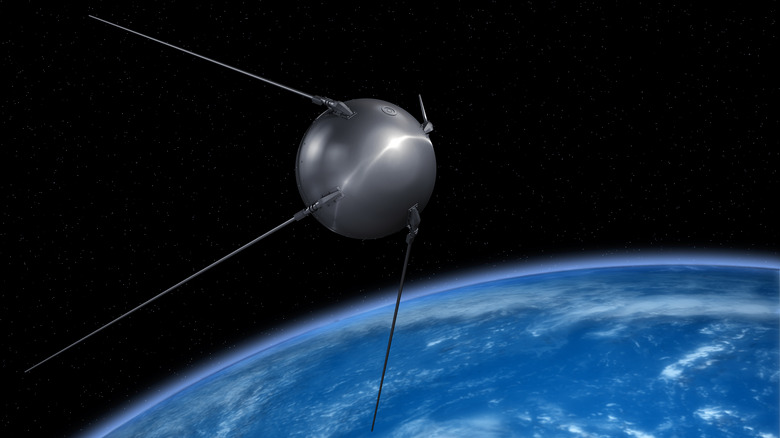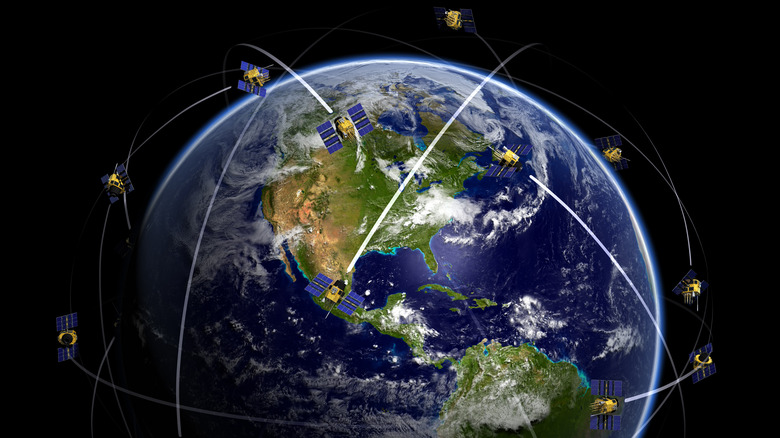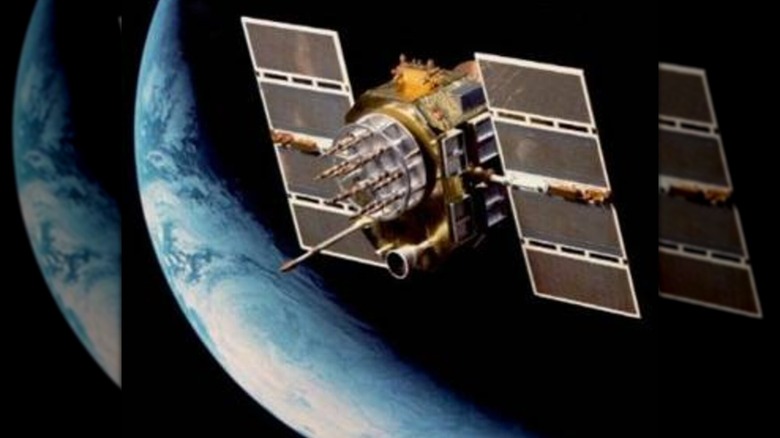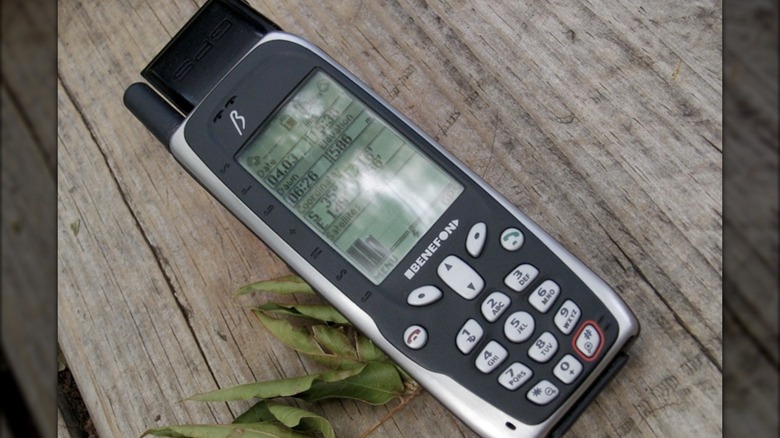Important Moments In The History Of GPS Navigation
The network of satellites and incredibly sophisticated mobile technologies that power GPS navigation has become a ubiquitous part of modern life. Unlike many other modern innovations, GPS systems are reletively new, coming into being in the latter half of the 20th century and becoming commercially available just over two decades ago. Many readers today will distinctly (and perhaps fondly?) remember "MapQuesting" directions to a new destination and printing out the results to help them navigate, lacking a portable GPS solution of their own. The terminology and dependence stayed with us for much longer than you might remember, too: In a 2010 episode of "The Office," Jim MapQuests directions to a daycare center that's two minutes down the road, just to be sure. Surprisingly, MapQuest remains an active website for those seeking directions, even as other tools have risen to dominate consumer GPS and wayfinding.
The origins of GPS technology began during the Cold War, with a fundamental discovery. Within a few decades of its conceptualization, the tool became a safety apparatus for commercial airliners, a battlefield supremacy item, and a fixture in civilian life. Today, GPS connectivity is a key functionality in all kinds of devices and industries, from smartwatches to agricultural planning. A few key milestones have shaped this technology and driven its rapid improvement. Here are some of the modern navigation tool's most important moments.
The Doppler effect gains new significance
Interestingly, the premise that spawned live GPS navigational tools is quite old, but the infancy of this discovery likely prevented people of the time from envisioning its future applications. GPS functionality relies on devices positioned in a constellation around the Earth — importantly, beyond its atmosphere. These satellites are so far from the Earth's surface that they can coordinate to identify an object's position below. However, to determine where something is positioned, you first need to know where you are. Thinking in reverse for a moment: This is a similar problem that ancient seafarers faced, solving their lack of situational awareness by using a set of fixed stars in the night sky.
When the Doppler effect was discovered in 1842, astronomers hadn't yet discovered all the planets in our solar system, and they certainly weren't actively thinking of ways to launch objects into the universe. In simple terms, the Doppler effect is the phenomenon that distorts the siren of an ambulance as it drives past you. Sound waves are compressed as the vehicle speeds toward you and spread out as it moves away. The same behavior is perceived in light traveling through space. In 1957, when the Sputnik satellite was launched, scientists discovered that the radio waves it emitted exhibited a similar Doppler effect. As Sputnik came closer to a receiver on the ground, its waves' frequency increased. Researchers at Johns Hopkins' Applied Physics Laboratory observed this Doppler effect behavior in the orbiting satellite and successfully began tracking its movement.
ARPA begins developing Transit in 1958
The research team quickly came to the realization that if a moving object in the sky could be tracked, then it could be utilized in the same navigational role for ground wayfinding in the same way that fixed stars once served our ancestors. Instead of calculating angles, however, an orbiting satellite would provide triangulated distances from receiver to aerial network, so long as more satellites could be successfully launched and positioned up there in the great beyond.
In 1958, shortly after the Sputnik launch and this breakthrough discovery of satellite functionality, ARPA began laying out plans in coordination with the Johns Hopkins University team to build "Transit." This would serve as the first navigational aid conceived by humanity that would place artificial satellites in orbit to provide consistent wayfinding tools for accurate navigation. No longer would humans need to rely on the stars or the whims of nature to understand where they were standing. By 1960, the first Transit satellite was launched, and eight years later, a full constellation of 36 satellites was orbiting the Earth to provide constant coverage for operators on the ground. The first users were American Naval forces, specifically missile submarines, who benefitted greatly from this development. Combined with precise charts on ocean floor geometry, a definitive understanding of where the boat was positioned could radically change the navigational clarity and confidence of a submarine full of sailors. It offered 10-meter accuracy and remained in use until 1996.
The Aerospace Corporation envisions 'lighthouses in the sky'
Retaining its thematic ties to ancient seafaring navigation, the expansion of GPS as a concept was contemplated by The Aerospace Corporation's founding president, Dr. Ivan Getting, as "lighthouses in the sky." The capability was thought of as a way to consistently know a user's location on the Earth's surface, assuring them of their position in relation to known hazards, lines of movement, and more. Just as a lighthouse illuminates a rocky shoreline, GPS satellites would help navigators on land, in the air, and at sea understand their position relative to their surroundings.
To achieve this breakthrough, however, satellite technology needed further advancements. The earliest satellites relied on sophisticated clocks in ground-based receiving tools. Users required incredible accuracy to pinpoint themselves against the locations of satellites above. In 1963, a new conceptual understanding began to take place through programs called 621-B and Timation. By the end of the decade, researchers had elaborated upon a triangulation method using four satellites to measure Earthbound positions at greater degrees of accuracy. Similarly, the highly accurate clock systems that once sat in receivers were reintroduced as a component in the satellites themselves, with two satellites featuring crystal oscillator clocks in orbit by 1970 and one with an atomic clock successfully reaching orbit in 1974. This allowed the orbiting devices to act as known beacons up above, shrinking the handheld tools that users required and massively reducing the cost to create navigational devices.
Navstar I is launched in 1978, placing the first functional GPS satellite in orbit
GPS took a huge step forward in the 1970s, transitioning from a loose network of satellites and receiving tools on the ground to a fully formed and operational GPS system. This marked the beginning of the shift toward the modern system we see and rely on today. Navstar I was the first GPS satellite launched, placed in orbit in 1978 by research teams from the U.S. Air Force. Around this time, the project also began to take on the moniker of "GPS."
Testing began at this time as well, with three more Navstar satellites launched before the year's end. Over 700 individual testing sequences were performed on this initial constellation of positioning tools to assess their accuracy and capabilities. By the early 1980s, additional satellites in the grouping designated Block I were launched, further rounding out the system.
Civilian commercial airlines get the green light to use the Navstar system in 1983
Amid the expanding network of Navstar satellites, a tragedy occurred that reshaped the importance and application of this system. Initially used exclusively within military circles, President Ronald Reagan declassified the system in 1983, allowing commercial airlines to get in on the action. The reason for this change was a Soviet shootdown. The Cold War was a time of great paranoia and a race to the bottom when it came to defensive posture and weaponry. Dozens of aircraft in the north Pacific and throughout border regions in Europe were shot down or experienced near misses as the two sides increasingly felt their security threatened. However, most of these events involved military aircraft. The Korean Air Disaster was different. On September 1, 1983, a Korean Air flight seemingly came too close to the Soviet border as it made its way from Alaska to Seoul and was shot down by a Soviet missile.
After the incident, the international community was united in condemning the Soviet Union. As a direct result, the GPS system that American military researchers had been expanding was made public and approved for use within commercial jets. The hope was to create a safer flying environment in which pilots knew exactly where they were in relation to border zones that might bring tremendous danger to their crew and passengers. Since its shift into the public sphere, GPS has gained significant momentum as a tool in improving everyday lives.
GPS technology underpins a war effort for the first time over Iraq
The Navstar/GPS system wasn't done serving as a high-tech tool of war, however. Less than a decade after it was rolled out to the public, the Magellan Nav 1000 hit the shelves in 1989. Retailing for $3,000, this was the first GPS device that was truly portable. Perhaps the most notable development during this period, however, was the system's use during the Gulf War. This marked one of the first major wartime uses of GPS, as the "global war on terror" later fell under "dates of recent conflicts" rather than formal wartime declarations by the federal government.
The GPS system was almost fully functional in 1991 when American military forces began their march into Iraq. It played a pivotal role in helping ground troops navigate the interminable desert landscape between Saudi Arabia and the sprawling river valley running through Iraq's center. In many instances, they navigated dune fields stretching for seemingly countless miles in every direction with no discernible paths or roadways to guide their movements. While American operators may have relied on early navigational technology running on satellite communications in other conflict zones, it was during the Gulf War that American forces first used GPS systems in wartime.
1994 marks the completion of the GPS satellite constellation with its 24th device
After the war, but before Americans had fully left the conflict's lingering stew, the final satellite required to complete the Navstar constellation was placed in orbit. In 1994, the 24th satellite was successfully added to the group, completing the requisite grouping that allowed for constant coverage by four satellites on the Earth's surface. This meant that users below could effectively use a GPS device anywhere to determine their precise location. When paired with mapped information about the surrounding area, it gave users a detailed atlas of their location and how they might navigate to a target destination. A year later, three more satellites were introduced to the Navstar constellation to provide redundancy in case of repair needs or failures in the existing devices.
While civilian users were finding new accuracy and utility in the tool, they faced a different kind of roadblock. In 1990, the American government had become worried that adversarial entities might exploit this highly accurate navigational tool to the detriment of U.S. interests and security. As such, non-military uses of the product were intentionally hamstrung by a practice known as "selective availability." This introduced deliberate errors into the system to reduce its effectiveness as a tool for conflict in the hands of non-military users. This intentional monkey wrench was similar to the obfuscation seen in satellite imagery over China – another measure designed to protect national defense capabilities.
Just before the new millennium, civilian users see GPS technology appear in their cell phones
In 1999, the Benefon Esc! was released, marking the debut of a GPS-enabled cell phone and opening the door to readily available, handheld GPS systems. Before this, GPS receivers were standalone tools, much like how early mobile phone users might also carry a Walkman or later an iPod — examples of technology made obsolete by the smartphone. Over time, cell phone technology absorbed these specialized devices into its infrastructure. The Benefon Esc! was the first step toward the integrated smartphone capabilities we now take for granted today (and it certainly won't be the last, given the enormity of promising new cell phone technology on the horizon).
Around the same time, vehicle-based GPS units became increasingly common. These dedicated devices that you could mount in your car were among some of the most high-tech gadgets you could gift a friend or family member at the time. They, too, were eventually overtaken by integrated navigation systems, which became standard features in many cars' onboard consoles.
2000 sees the approval of three new GPS signals for civilian use, and the end of 'selective availability'
Ten years after it was introduced, the use of "selective availability" ended. This made civilian applications of GPS systems significantly more accurate and far more empowering. Estimates suggest that this decision instantly improved accuracy for non-military uses by ten times. GPS receivers and processing chips also plummeted in cost, from around $3,000 in their earliest iterations to about $1.50, making the tools abundantly available for all manner of civil uses.
In 2000, three new GPS signals were approved for civil applications, making the service widely available for all kinds of routine tasks. Improvements in shipping, location-based services, and many other commercial uses followed these developments. The new millennium brought with it plenty of incredible breakthroughs in GPS capabilities, supporting niche uses such as GPS devices for your camping adventure or delivering AR features in Google Maps, thanks to the removal of earlier restrictions.
The 21st century sees GPS II and GPS III take flight, improving security, accuracy, and user experiences
In 2004, Qualcomm rolled out a combined GPS system called live assisted GPS. This paired a cellular device's GPS signal with its cell tower connectivity to improve accuracy even more. GPS II blocks included five different configurations by 2005, with new signal tools incorporated into every satellite launched since approvals for new systems were finalized in 2000. In 2008, the first contracts to build out a GPS III system infrastructure were awarded, and in 2018, SpaceX successfully placed a GPS III satellite into orbit aboard a Falcon 9 rocket. More enhanced satellites were launched in the years following that initial success (some delayed, creating a hectic launch schedule with back-to-back departures), with the final spate of GPS III's first generation taking to the skies to close out 2024.
Moving forward, additional launches are slated for liftoff via ULA and SpaceX rockets every few months to remain ahead of systematic decommissionings. The current thinking is that the atomic clocks powering the GPS revolution retain their accuracy for around 25 years, requiring replacement after this point to continue offering the most accurate navigational results to users on the ground. Continued improvements are in the works, too, leading to increased functionality, granular accuracy that continues to improve, and enhanced security and user accessibility.










